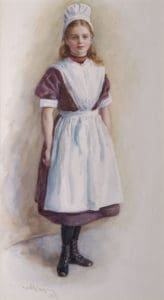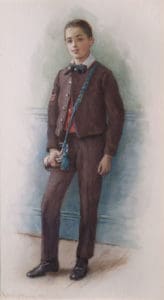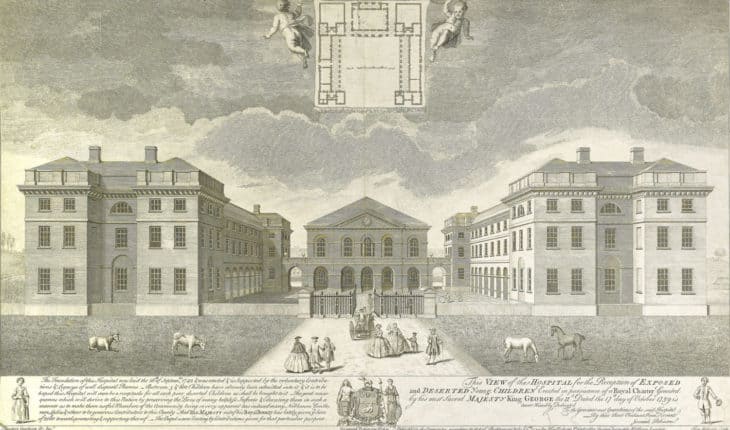Foundling Portraits Campaign, a new display at London’s Foundling museum until 27th February 2022, capturing the likenesses of the last surviving children cared for at London’s Foundling Hospital, between 1741 – 1954.
At the Foundling Museum, London until 27th February 2022 and enlisting the help of five major artists, including Wolfgang Tillmans, a new display, Founding Portraits Campaign, supported by the Art Fund, captures the likeness of the last surviving children cared for at London’s Foundling Hospital between 1741 – 1954.
Often abandoned and dying on the streets of London in Dickensian times, more than 25,000 children were given into the care of the Foundling Hospital, cared for them until they were old enough to be apprenticed to a trade. This continued until well into the twentieth century. The Museum commissioned portraits of the few last surviving former pupils of the Foundling Hospital to commemorate their lives and to revolutionise its 280 year old collection and they now hang alongside the grand paintings of the Hospital Governors and benefactors.

Foundling Girl, 1919, c. The Foundling Museum
The exhibition honours Thomas Coram, the eighteenth century philanthropist who was so appalled to see children suffering on London’s streets that he started the Foundling Hospital in 1741 to care for them. It was the UK’s first children’s charity and continues today as Coram. Mothers brought their babies to the hospital where they would be given a new name. The custom was for mothers to leave a token with the hospital, such as a button, a scrap of fabric, or a coin, so that the child could be identified if the mother enquired about, or wanted to claim the child. The tokens were usually some small, or useless thing which had been precious to the woman who was about to part with a living being she would have nurtured and loved had she been able to support them both. Babies left with the hospital had often been born to unmarried, women who were often servants or factory workers and too poor to support a child. They were frequently abandoned or left to die. As a result there was opposition to provide any support for these children as people thought this would encourage immorality. Unusually at the time, Thomas Coram had compassion for the desperate mothers and their babies. He was concerned that the mothers would be able to resume ‘a useful life’ as well as providing care and education for their children.
As an experienced campaigner, Coram realised that it was important to gain the support of wealthy and powerful patrons for the hospital. He dedicated seventeen years to campaigning for the Foundling Hospital to be built and managed to gain the backing of ’21 ladies of distinction’ after his plan was dismissed by many powerful men. King George II signed the Foundling Hospital Charter in October 1739 and a large board of wealthy and influential Governors was drawn up at a meeting at Somerset House, London, soon after.

Foundling Boy, 1919, c. The Foundling Museum
The last surviving Coram pupils were admitted to the Hospital in the 1940 and 50s and are now relatively few in number. Ensuring their portraits could be captured before this last direct link to the past was gone forever, the project led by the Foundling Museum received generous support from Art Fund and the public through a public campaign.
The Foundling Museum’s remarkable art collection is rooted in the eighteenth-century, when under the leadership of the artist, William Hogarth, contemporary artists, musicians and craftsmen, donated their work to support the Foundling Hospital. Thanks to the artists’ involvement, the Hospital became the UK’s first public art gallery and led to the founding of the Royal Academy.
Over 200 years, the Hospital admitted approximately 25,000 children but until now, not one was represented in the Museum’s collection, making the children an absent presence and the portraits of the great and the good that line the gallery walls, a very ‘top down’ telling of history.
Reflecting the calibre of the eighteenth-century artists who donated their works to help the children, and the importance of the sitters who embody the historic story of care, the Museum commissioned five exceptional photographers to each create a portrait of a former pupil of the Foundling Hospital: Jillian Edelstein, Mahtab Hussain, David Moore, Ingrid Pollard and Wolfgang Tillmans.
Jillian Edelstein’s portraits have appeared in publications including The New Yorker, The New York Times Magazine, Vanity Fair, Vogue, and Time, and have been exhibited internationally. She photographed Henry, 84, who entered the care of the Hospital in 1942. Mahtab Hussain is an artist whose work explores the important relationship between identity, heritage and displacement. Hussain photographed John, 85, who was in the care of the Hospital until 1952. David Moore’s work uses and interrogates documentary modes and looks at the agency of the subject within historical and contemporary Gallery, the Royal Academy, the National Portrait Gallery and the National Museum of Photography, Film and TV, Bradford, and his work is held in many public and private collections. Moore photographed Lydia, 87, at the Foundling Hospital’s Berkhamsted site, where she lived from the age of 5-15. Ingrid Pollard uses portraiture and traditional landscape imagery to explore social constructs, such as Britishness and racial difference. Pollard has photographed Jocelyn, who is 87. Wolfgang Tillmans photographed Ruth, 84, who entered the Hospital in 1942.
Accompanying the project is a documentary film, The Sitting, by director Gilly Booth, which animates the story of these remarkable sitters and artists, bringing an extra layer of visibility and voice to the lives of the 25,000 children that this project commemorates.
If you’d like to read more about the lives of foundlings, Rose Tremain’s powerful new historical novel, Lily, set in Victorian London, published by Chatto & Windus this month, explores the life of an abandoned baby found in a freezing east London churchyard by a young police constable, who takes her to Coram’s Foundling Hospital, where against the odds, she survives. It is rather like a fairy tale for adults and provides perfect reading when you need an escape from the pressures of working for the NHS over the winter months.
Visitor Information
Foundling Portraits Campaign until 27th February 2022 at the The Foundling Museum, 40 Brunswick Square, London WC1N 1AZ +44 (0)20 7841 3600 / foundlingmuseum.org.uk Open: Wednesday – Sunday 10:00-17:00, Monday & Tuesday closed Admission: Adults £10.50 with donation, Concessions £8.25 with donation.
Free for 21 & under, Foundling Friends & National Art Pass holders Lily, by Rose Tremain published by Chatto & Windus, in hardback, on November 4th 2021, priced at £18.99p
- People’s Choice Victory for Down’s Syndrome Scotland Garden at Chelsea 2025 - 28th May 2025
- Cadogan: A Chelsea Family By Tamsin Perrett - 3rd May 2025
- Dream Worlds a new exhibition in Cambridge - 14th December 2024







